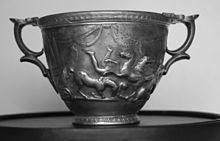Silver mug from Grünau
The Grünau silver beaker is a skyphos made of silver or gold , which was discovered in 1990 during the excavations in the Roman villa of Grünau (community Groß Sankt Florian , district Deutschlandsberg ). It is one of the most valuable Roman times finds from the area of today's Austria and is now in the archaeological museum in the Universalmuseum Joanneum in Graz , a copy is on display in the fire brigade museum in Groß Sankt Florian.
To find
Between 1988 and 2008 excavations took place in the area of a Roman villa rustica in the district of Grünau, which led to the uncovering of a large main building and two auxiliary buildings. In addition, two groups of burial mounds were uncovered. The excavations were carried out by the Institute for Archeology at the University of Graz (excavation manager: Erwin Pochmarski ) and the Department of Archeology and Coin Cabinet of the Universalmuseum Joanneum (excavation manager: Barbara Porod). The silver cup was discovered in 1990 in the area of the peristyle courtyard of the main building. When it was found, it was separated into the outer and inner cup, the two handles and the base. During the subsequent restoration ( Kunsthistorisches Museum Vienna ) it could be put together without any problems.
description
Its dimensions are: height 7.5 cm (middle of side B) or 7.65 cm (middle of side A); Diameter above including handles 13.7 cm, outside without handles 9.6 cm, below outside 4.9 cm. It weighs 412 grams.
It is made of silver, the inner cup is made of gold, and there is more gold plating on the upper edge of the cup.
- The vessel jacket, which is decorated in relief, is largely undamaged. A scene from the Roman circus is depicted on each of the sides A and B, separated by the handles, and the depictions are framed by garlands.
- On side A, the front of the cup, a team of four is shown on their way to the start boxes. The charioteer is just getting into the carriage, the horses are accompanied by two assistants walking on foot and a rider galloping ahead.
- Side B, the back of the mug, shows the fall of a charioteer in the curve of the circus. He falls headlong over the neck of the first horse, all four horses of the team have lost their position in front of the wagon. An assistant is holding one of the horses by the reins in front, a figure hurries up from behind, with its right hand raised to its head in a gesture of dismay.
Dating
The excavator Erwin Pochmarski dates the silver cup to the middle of the 1st century due to the shape of the vessel, the manufacturing technique, the spatial conception and the composition of the picture. A.D.
literature
- Erwin Pochmarski , Barbara Porod: The Silver Scyphus of the Roman Villa of Grünau (Gross St. Florian, Styria, Austria) - Expression of the Otium of a Roman Villa Owner, in: Histria Antiqua 16/2008, 23–33.
- Erwin Pochmarski : Silver beaker (Skyphos) from Villa Grünau, in: Barbara Porod (Hrsg.), Roman Museum Villa Grünau (Groß St. Florian no year) 20–23.
- Paul Bayer, Susanne Lamm: More than just Ben Hur - A 3D unrolling of the Roman silver cup from Grünau, Styria, Forum Archaeologiae 87 / VI / 2018.
Web links
- Podcast about the mug: https://1lpmzl.podcaster.de/artefakte-erzaehlen/2-wie-viel-wein-passt-da-hinein-oder-wagenrennen-mit-achsenbruch/
- Museum homepage UMJ www.museum-joanneum.at
- Museum homepage Fire Brigade Museum www.feuerwehrmuseum.at
- Article in the new museum 08/4 from February 2009, p. 34. PDF (4.3 MB)

